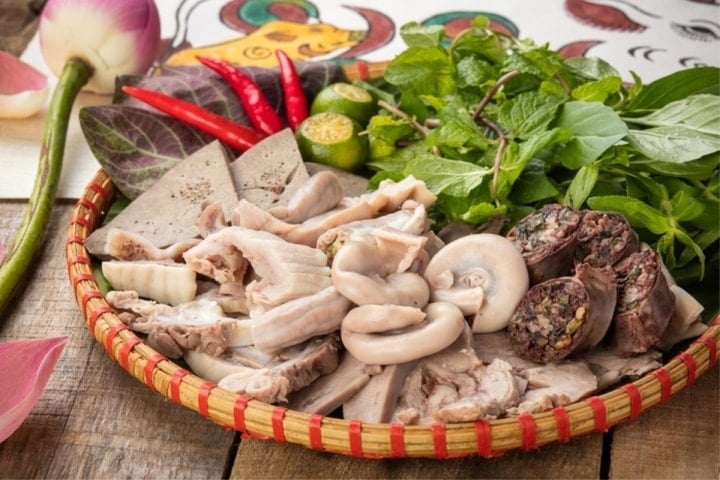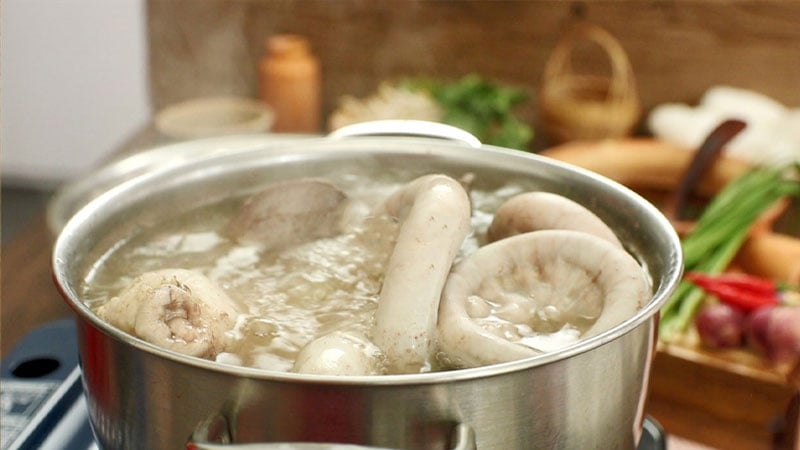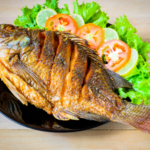How to Boil Perfectly Crispy Pork Stomach
Pork stomach, or pork belly, is a delicacy loved for its crispy texture and delicious flavor when prepared right. To achieve the perfect crunch, attention to detail is key, from preparation to boiling technique. Here’s a step-by-step guide to help you master this mouth-watering dish:
Ingredients for Pork Stomach Boil
Pork stomach (belly): 500g
Ginger: 1 small root (about 20g)
Red onion: 2 bulbs
White wine: 2 tablespoons
Vinegar: 2 tablespoons
Salt: 1 teaspoon
Kaffir lime leaves: 3-4 leaves

Step 1: Prepare the Pork Stomach
Clean the pork stomach: Rinse the pork stomach under running water, turning it inside out to remove any slime and dirt.
Use salt and vinegar for extra cleaning: Place the pork stomach in a bowl, add 1 teaspoon of salt and 2 tablespoons of vinegar. Knead it for 3-5 minutes, then rinse with clean water. Repeat this process once or twice to eliminate any unpleasant odors.
Remove odors with white wine: Add 2 tablespoons of white wine to the pork stomach and knead it evenly. Rinse again. The wine enhances the aroma and removes any lingering odors.
Step 2: Prepare the Boiling Broth
Boil 1.5 liters of water in a pot. Pound the ginger and onion, and add them to the boiling water along with the kaffir lime leaves. This will infuse your broth with a delightful fragrance. Add 1/2 teaspoon of salt to season the pork stomach during boiling.

Step 3: Boil the Pork Stomach
First boil: Place the pork stomach in the boiling broth and cook for about 3-5 minutes. This initial boil helps seal the meat and remove any remaining impurities. Remove the pork stomach and rinse it under cold water.
Second boil: Use fresh boiling water or filter the existing broth to ensure cleanliness. Boil the pork stomach for another 20-25 minutes over medium heat. To check if it’s done, poke the meat with a chopstick; if no pink liquid comes out, it’s ready.
Tip for maintaining crispiness: As soon as the pork stomach is cooked, remove it from the broth and plunge it into a bowl of ice-cold water (you can add a few ice cubes). Soak it for about 5-7 minutes; this will cause the meat to contract and achieve that desirable crispy texture.
Step 4: Serve It Up!
Take the pork stomach out of the ice bath and let it air dry. Slice it into thin, bite-sized pieces. Well-boiled pork stomach should be a beautiful white color, crispy yet not tough, and fragrant with hints of ginger and kaffir lime. For the ultimate flavor experience, dip the meat in a salt, chili, and lime mixture or a fish sauce dip with garlic and chili.
Elevate your dish by pairing it with fresh herbs like lettuce, basil, or banana blossoms, or turn it into a mouth-watering salad. You can also use the boiled pork stomach as a base for other delicious dishes like stir-fried pork stomach with cucumber or turmeric.
Always choose fresh pork stomach that’s pinkish-white and free from strange odors. Avoid overboiling, as this will make the meat tough and ruin its crispy texture.

The ice bath is the secret to achieving that perfect crispiness. With these simple steps, you’ll be able to serve up a delicious boiled pork stomach that your family and friends will rave about. Good luck, and bon appétit!
The Ultimate Fish Fry: Achieve Crispy, Evenly Cooked Perfection with This Simple Trick
For many, frying fish is a daunting task, often resulting in a sticky mess, with the fish falling apart, unevenly cooked, or smelling and tasting unpleasant. But fear not, with a simple, inexpensive ingredient and a few expert tips, you can fry fish to perfection, achieving a crisp, golden exterior with a tender, flaky interior, and no unpleasant odors.
The Underground Delicacy: A Surprise Package of Flavor and Health.
The humble tuber, devoid of any prominent aroma, has captivated the hearts (and taste buds) of many. With its unique flavor, satisfying texture, and remarkable ability to satiate hunger, the nưa root vegetable is emerging as a culinary sensation across Vietnam, from the mountainous regions of the Northwest to the provinces of the Central and Southern regions. This unassuming root vegetable is poised to become a culinary staple, seamlessly blending traditional flavors with modern culinary innovation.



































